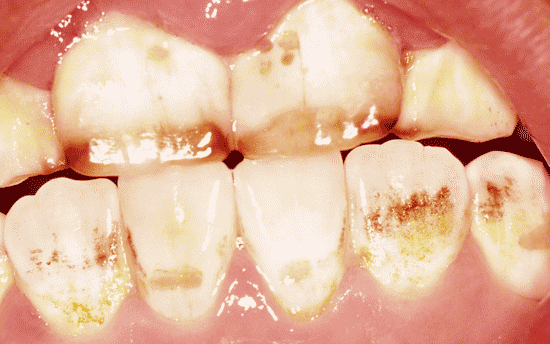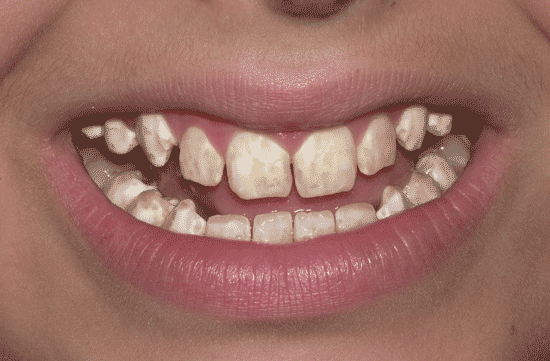
Severe fluorosis – Photograph by David Kennedy, DDS
In its severe forms, dental fluorosis causes highly disfiguring brown and black staining of the teeth, which can cause chronic embarrassment and social anxiety for the impacted child. In 1984, a panel from the National Institute of Mental Health (NIMH) warned that severe dental fluorosis would place a child at risk of psychological problems due to the “loss of self-esteem” and impairment in “self-image” from having disfigured teeth. Subsequent research has found that children with severe fluorosis are often teased in school for having “dirty” or “filthy” teeth and are often reluctant to smile or show their teeth. (Silva de Castilho, 2009; Marshman, 2008). Research has also found that young adults attach many negative attributes to people with severe fluorosis, such as being less attractive, less clean, less healthy, less intelligent, less reliable, and less social than those with non-fluorosed teeth (Bennett, 2008; Williams, 2006). Children with severe fluorosis can thus experience significant “psychosocial suffering.” (Silva de Castilho, 2009).
| Results of U.K. National Survey on Aesthetic Perceptions of Dental Fluorosis | |||
| TF Score | % of people who find the teeth unattractive | % of people who would not be satisfied with appearance | % of people who think treatment is needed |
| 1-2 (Very Mild/Mild) |
34% | 36.1% | 28.9% |
| 3-4 (Mild/Moderate) |
63.1% | 58.8% | 68.5% |
| >5 (Severe) |
99.5% | 99.5% | 90.6% |
| SOURCE: Alkhatib MN, et al. (2004). Aesthetically objectionable fluorosis in the United Kingdom. British Dental Journal 197:325-28. | |||
| Characteristics Attributed to Individuals Upon Viewing Their Teeth | ||
| Characteristic | No Fluorosis | Severe Fluorosis |
| Dirty | 16.5% | 81.5% |
| Unattractive | 38.6% | 78.5% |
| Unhealthy | 20.3% | 73.1% |
| Careless | 24.2% | 64.3% |
| Unsocial | 9.5% | 58.9% |
| Unreliable | 20.3% | 43.0% |
| Unintelligent | 21.7% | 34.4% |
| SOURCE: Bennett P, et al. (2008). A reaction-time study of social, health, and personal attributions in relation to fluorosed teeth. Psychology, Health & Medicine 13:75-86, Table 1. | ||
excerpts from the scientific literature:
“This paper describes the psychosocial consequences of [severe dental fluorosis] and how it has affected the self-esteem of adolescents and young people in a rural area in Brazil. Semi-structured, face-to-face interviews were carried out with 23 adolescents and young people affected by severe dental fluorosis and 14 of their teachers. The study revealed the affected individuals were embarrassed to smile at strangers due to a presumed association between fluorosis and a lack of dental hygiene. Further findings include conflicts between affected and non-affected students at school, problems in pursuing a romantic relationship and uncertainties regarding a professional future. Disbelief and scepticism were observed regarding the ethical position that science can offer a solution to the problems stemming from the disease. Lesions from severe dental fluorosis appear to be a stigmatising factor and have contributed toward suffering and self-exclusion among an entire generation of adolescents and young people.”
SOURCE: Silva de Castilho L, et al. (2009). Perceptions of adolescents and young people regarding endemic dental fluorosis in a rural area of Brazil: Psychosocial suffering. Health and Social Care in the Community 17:557-63. [See excerpts from this study]
“There is little dispute that severe fluorosis is a cause for aesthetic concern.”
SOURCE: Williams DM, et al. (2006). Characteristics attributed to individuals with dental fluorosis. Community Dental Health 23:209-16.
“The present data indicate that dental fluorosis impacts negatively on the functional, social and psychological well-being of secondary school children in Arusha.”
SOURCE: Astrom AN, Mashoto K. (2002). Determinants of self-rated oral health status among school children in northern Tanzania. International Journal of Paediatric Dentistry 12:90-100.
“the more severe forms can cause great psychological distress to the affected individual.”
SOURCE: Rodd HD, Davidson LE. (1997). The aesthetic management of severe dental fluorosis in the young patient. Dental Update 24: 408-11.
“Dental fluorosis was viewed as an important problem because of its unfavourable effects on an individual’s personality by between 60.4 and 84.3% of the respondents.”
SOURCE: Mwaniki DL, et al. (1994). Endemic fluorosis: an analysis of needs and possibilities based on case studies in Kenya. Social Science and Medicine 39: 807-13.
“Feelings of distress and worry and hindered smiling were expressed by children and more so among those who exhibited more severe dental fluorosis.”
SOURCE: van Palenstein Helderman WH, et al. (1993). Impact of dental fluorosis on the perception of well-being in an endemic fluorosis area. Community Dentistry & Oral Epidemiology 21:243-44.
“Mottling of teeth can have significant psychological impact on patients — particularly on adolescents, who may be subjected to much unkind teasing.”
SOURCE: Welbury RR, Shaw L. (1990). A simple technique for removal of mottling, opacities and pigmentation from enamel. Dental Update 17: 161-3.
“An independent panel, convened at EPA’s request to study the question of psychological and behavioral effects, concluded that persons with dental fluorosis could be at risk of ‘behavioral problems’ as a result of an ‘impaired self-image’ or ‘loss of self-esteem.’ In particular, the panel believed that dental fluorosis would effect the perception of physical attractiveness. The panel noted that facially attractive persons are viewed as more self-confident and are thought to be more socially skilled. Persons who are not perceived as physically attractive are believed to avoid social behaviors requiring responsiveness, be less academically successful and be more dissatified with their physical appearance. In some cases, the panel believed that this could result in psychological distress or anxiety. In addition to the panel report several persons have informed the Agency that they suffered embarrassment and an impared self-image from dental fluorosis and that they did not want mottled or pitted teeth.”
SOURCE: Environmental Protection Agency. (1985). National Primary Drinking Water Regulations; Fluoride. Final Rule. Federal Register November 14; 50(220): 47142-47155.
“The stains of endemic dental fluorosis can have a tremendous psychological impact on the patient.”
SOURCE: Colon PG. (1972). Removal of Tooth Stains in Prisoner Rehabilitation. Dental Survey 48: 30.
“A matter which should not be overlooked in this, is the mental attitude of these persons. I have found it very difficult to obtain a good opportunity to examine these teeth in the mouth because the persons have been so sensitive to such observation. One of them told me that he had almost completely retired from society because people stared at him as though there was something about this countenance that was uncanny.”
SOURCE: McKay FS, Black GV. (1916). Mottled teeth. Dental Cosmos 58: 129.
For research on the perceptions and psychological impact of “mild” fluorosis, click here.

